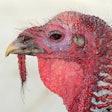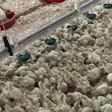
The sudden spate of new outbreaks of highly pathogenic avian influenza (HPAI) in European countries has been followed by the first calls for restrictions on the trade of poultry meat and eggs.
French campaigner Coordination Rurale has called for all poultry movements from infected countries to be halted. Justifying the call, the group highlighted the huge and long-lasting impacts on the country’s poultry sector as the result of an outbreak of the disease in recent years.
Last week, the United Arab Emirates banned the import of birds, and some egg and meat products from Hungary and Slovakia. The move followed the announcement of HPAI outbreaks in those states, reports EsquireME.
After HPAI was confirmed in Ukraine for the first time, poultry producer Myronivsky Hliboproduct (MHP) stated that the disease does not currently threaten its operations. It also stressed the high level of biosecurity at its poultry complexes.
According to the European poultry meat producers’ association AVEC, the European Union exported 1.58 million metric tons of poultry meat in 2018.
First cases in Czech Republic, Ukraine
With new cases confirmed in the Czech Republic and Ukraine, the number of European states reporting HPAI in poultry so far this winter has risen to seven over the past week.
For the Czech Republic, this was the first time that the H5N8 HPAI virus had been detected in the country. According to the report from the State Veterinary Administration to the World Organisation for Animal Health (OIE), the presence of the virus was confirmed after six birds in a backyard flock in the central-southern region of Vysocina earlier this month. The rest of the flock has been destroyed.
After an absence of almost three years, the same virus has returned to Ukraine. It was detected in a commercial flock of 98,000 poultry of unspecified type in the western oblast of Vinnitsa, according to the national animal health agency. It reported to the OIE that the source of the infection is unknown. Almost 5,000 of the birds died, and the rest of the flock was in the process of being culled at the time of reporting.
Further outbreaks in Hungary, Poland, Romania, Slovakia
Following reports in local media, Poland’s agriculture ministry has confirmed to the OIE a further six outbreaks of HPAI in poultry to the OIE over the past week.
Since the first cases on December 31, more than 91,000 poultry have been lost to the disease through mortality or culling. Four of the outbreaks were in the central province of Greater Poland (Wielkopolskie), and one each in West Pomerania (Zachodnio-Pomorskie) and Lower Silesia (Dolnolaskie). The first borders Germany, and the second shares a frontier with the Czech Republic.
The same H5N8 HPAI virus has been detected for the first time in a wild bird in Lublin province in southeastern Poland. Affected was a goshawk found dead in a forest.
Hungary’s agriculture ministry has reported to the OIE a further two outbreaks of HPAI linked to the H5N8 virus variant. Two flocks of fattening turkeys totaling 54,000 birds have been destroyed after confirmation of the infection. As in the country’s first outbreak, these were at farms in Acs in the northern region of Komarov-Esztergom.
H5N8 HPAI has been detected at a second farm in Maramures in northwestern Romania. The animal agency reports that more than 22,700 poultry were affected by this outbreak.
In Slovakia, a second backyard poultry flock has been hit by the same virus variant. There were four cases among 19 birds at a unit in the region of Trvana. This is in the west of the country, and borders Nitra where the country’s first cases were recently confirmed.
Germany reports first HPAI case in wild bird
According to the federal agriculture ministry report to the OIE, the H5N8 HPAI virus was detected in a wild goose last week. The birds had been found dead in the Brandenburg region of eastern Germany, which shares a border with Poland, where the same virus has been detected.
Detection of the virus represents the return of the disease to Germany — as in other European states since the start of the year — after an absence since 2017.
Taiwan reports 11 HPAI outbreaks, 61,000 poultry affected
Over the past week, Taiwan’s Council of Agriculture has reported 11 new outbreaks of HPAI to the OIE. These involved two different variants of the virus.
Latest in its five-year battle to control HPAI linked to the H5N2 virus were six outbreaks involving almost 50,000 birds. Five of these outbreaks affected native chickens, and the other was confirmed in a turkey flock. Affected premises were in the counties of Yunlin, Yilan, and Changhua, as well as the city of Taichung. Two cases were detected among a group of 20 native chickens at a slaughterhouse in the Wanhua district of Taipei city.
The H5N5 HPAI virus subtype emerged in Taiwan in September of 2019. The number of outbreaks has risen to 11 with the Council of Agriculture informing the OIE of five new outbreaks over the past week.
One of these outbreaks was confirmed after around 1,000 birds died out of a flock of almost 11,000 native chickens at Mailiao in Yunlin county. The virus was also detected in four groups of native chickens that showed suspicious symptoms at a Wanhua slaughterhouse.
Avian flu detected again in Chinese wild bird
Further cases of HPAI in wild birds have been confirmed in China’s Xinjiang province.
According to the agriculture ministry’s latest report to the OIE, the H5N6 virus variant was detected in a mute swan found dead in a natural park in the Bayingol Mongolian Autonomous Prefecture. It was part of a flock of around 150 birds.
At the end of December, the same virus was detected following mass mortalities of mute swans in two other districts of the same province.
More avian flu in South African ostriches
HPAI viruses of the H5N8 subtype have been detected among two more flocks of commercial ostriches, according to the latest report from the South African agriculture department to the OIE. Affected were two farms in the Oudtshorrn region of Western Cape Province, and the outbreaks were confirmed in October of 2019.
South Africa reported its first cases of the disease in June of 2017. The latest cases bring the total number of outbreaks since that time to 215, based on the OIE reports.
Mexico declares avian flu situation “resolved”
Mexico’s animal health agency (SENASICA) has declared to the OIE that the notifiable avian flu situation affecting the country’s poultry sector has been resolved.
According to the reports lodged with the OIE, there were 33 outbreaks of HPAI linked to the H7N3 virus between March and October of 2019. These led to the direct loss of more than 1.03 million birds. A period of 90 days has elapsed since the last case of the disease was detected following intensive surveillance.
View our continuing coverage of the global avian influenza situation.
















